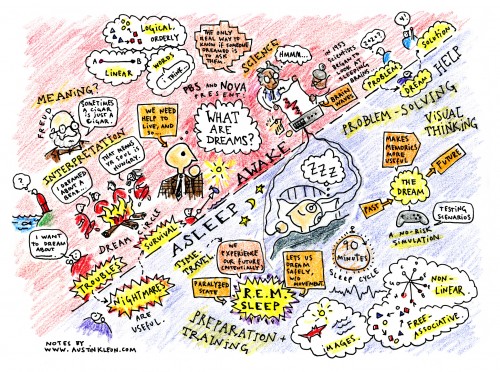The folks at PBS asked me to be a guest blogger for their “Remotely Connected” blog. I blogged about the upcoming NOVA episode, “What Are Dreams?”
Read my post at the Remotely Connected blog, or below:
“I like to sleep so I can tune in and see what’s happening in that big show. People say we sleep a third of our lives away, why I’d rather dream than sit around bleakly with bores in “real” life. My dreams…are fantastically real movies of what’s actually going on anyway. Other dream-record keepers include all the poets I know.”
– Jack Kerouac
Like all artists since the beginning of time, I’ve looked to dreams for inspiration.
I started writing down my dreams as a teenager, after I got my hands on Jack Kerouac’s Book of Dreams–dreams he collected by scribbling in his notebook the minute he woke from sleep.
Later on in college, I studied just enough psychology to learn that the creative process mirrors the dreaming process. As the film director David Mamet says in his book On Directing Film, “The dream and the film are the juxtaposition of images in order to answer a question.” Not only can the dream provide us with material, but the process of dreaming itself can provide us with inspiration towards a process of working.
Any artist will tell you that when the work is going really well, it’s as if you’re taking dictation. The characters speak because they want to speak. The act of art-making is an attempt to fall into a kind of dream state. We do this by abandoning the linear and the logical for the non-linear and the free-associative. This is when creativity happens.
After watching this NOVA episode, I pulled out my pen and crayons and attempted to digest what I had seen through drawing–juxtaposing images in space. It was not unlike dreaming, watching the images come out of my hand…

I like this drawing!
Your picture says that nightmares are useful–this is intriguing. I think I agree with you.
Thank you for this look at the neurophysiology of sleep cycles and dreaming. There is a larger story to be told. One of the world’s greatest mathematicians, Srinivasa Ramanujan, left a notebook of 6000 theorems behind when he died, each given to him in a dream. In Mayan dream interpretation, most dreams are interpreted much the same as in western psychology, but there is an understanding that with the supression of ego, dreams can provide more, a door for revelation. There is more on Mayan dreaming at the mayan dream box site, and the opportunity to create an environment for Mayan dreaming while supporting kids with Cystic Fibrosis.
The Ramanujan example is a great one in the context of this drawing. I’ve known about it for years but wouldn’t have put it into this context. Doesn’t most of the narrative in Flatland occur during dreams?